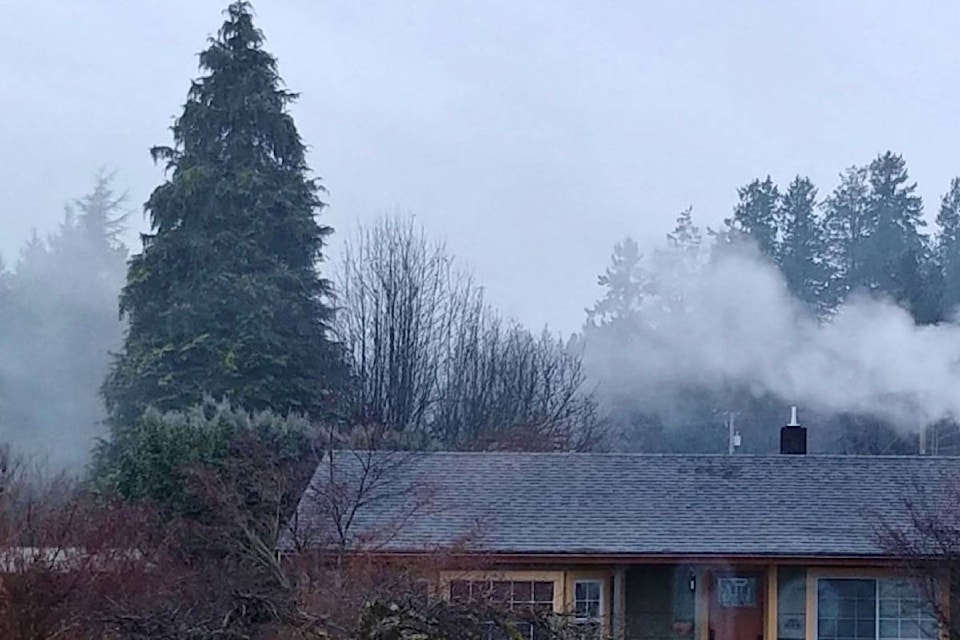Candidates in the local government elections have responded to an air quality questionnaire distributed by Breathe Clean Air Comox Valley. Over 95% of the candidates provided full or partial responses, and the vast majority were supportive of action on air quality.
The online survey, available on Breathe Clean Air’s website, highlighted the fact that the Comox Valley experiences multiple air quality advisories every winter due to wood smoke and frequently exceeds national air quality standards. The fine particulates in wood smoke are known to cause a range of health issues.
“We were very glad to see that 100% of the candidates indicated concern about winter air quality in our area and how it is affecting people’s health,” said Jennell Ellis, a volunteer with Breathe Clean Air. “Even better, we learned that all but one are committed to ensuring meaningful, multi-pronged strategies for reducing wood stove pollution are created and implemented.”
There was somewhat less consensus on the question about the role of certified wood stoves in addressing the problem in populated areas. The questionnaire provided research information that showed a brand new eco-certified stove, burning dry wood at high temperatures, will emit more harmful fine particulate matter per hour than 18 newer diesel cars. It also noted that a government agency in Puget Sound indicates that a well run EPA certified wood stove puts out 582 times more fine particulates a year than a gas furnace or stove.
The question Breathe Clean Air asked about stoves was: “Do you agree that replacing older wood stoves with newer, certified stoves is not the best approach for reducing wood stove pollution in populated areas?” Of the 44 respondents, 32 agreed, 6 did not agree, and 6 skipped this question.
“We’d all agree that no one should have to live next to 18 idling diesel cars but, for some reason, some still believe getting people in residential neighbourhoods to install certified stoves is a good solution,” said Ellis. “The reality is that no one runs their wood stove as well as a factory test, no matter how much public money we spend on educating them. So most neighbours experience a lot more than 18 diesel cars worth of fine particulates per chimney. We really need to focus on supporting people to move to cleaner, non-wood heating options, particularly in more populated areas.”
The questionnaire also asked about a candidate’s commitment to creating nuisance like bylaws that would help neighbours protect their families and property from harmful amounts of smoke created by poor burning practices. There was very strong support for this, with 39 saying yes, 1 no and 4 skipping this question.
“Neighbours can protect themselves from noise and even unsightly premises; it only makes sense that they should be able to protect themselves from people who burn poorly, or burn illegal materials,” said Steven Faraher-Amidon, another Breathe Clean Air volunteer.
The last question asked about people’s support to ending yard waste burning in CVRD, particularly in more populated neighbourhoods. Thirty-one supported this while 7 said no, and another 6 did not respond to this question.
“Fortunately, yard waste burning is now illegal in Comox, Cumberland and Courtenay. But many neighbourhoods in CVRD are just as populated—and neighbours just as impacted—by huge amounts of smoke from burning usually wet materials,” explained Ellis. “We asked all candidates this question as a number will end up representing their municipality on the CVRD board.”
Over half of the candidates also provided additional comments elaborating on their answers or suggesting ways of moving forward.
“It is great to see so many candidates who care about this issue and taking the time to provide responses,” Faraher-Amidon added. “We really encourage voters to look at the responses and consider which candidates are committed to improving air quality in their area and to continue raise the issues during the campaign.”
The five questions each called for a yes or no answer.
“A few candidates said they weren’t comfortable with the yes/no approach but we felt candidates should be able to clearly identify whether or not they support something, or whether or not they believe something is an effective solution,” noted Ellis. “For all of the questions, a “yes” answer reflects agreement with Breathe Clean Air’s positions and our understanding of what is needed to make a real difference in our air quality.”
Answers from each candidate are available on the Breathe Clean Air website: www.breathecleanair.ca/election2018.
Candidates were given 10 days to respond to the questionnaire. Only two did not respond.



